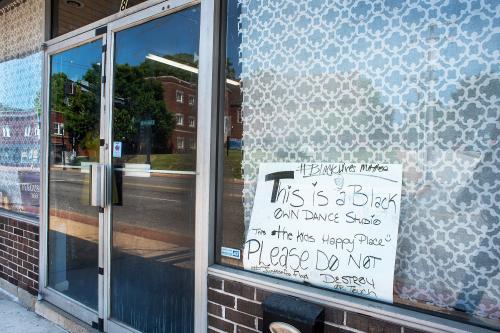The April 27th Hutchins Center virtual event devoted to our new book, From Here to Equality: Reparations for Black Americans in the Twenty-First Century, resulted in too many participant questions to answer live. We take the opportunity here to respond to nine that remained.
To provide a frame for our responses, we outline the premises that shape our conception of Black reparations in the United States. Data from the 2016 Survey of Consumer Finances (the most recent available) indicate that Black Americans possess 2.6 percent of the nation’s wealth while constituting 13 percent of the population. The average Black household has a net worth $800,000 lower than the average white household. This, in turn, corresponds to a vast chasm in capabilities and opportunities between Blacks and Whites.
The origins of this gulf in Black and White wealth stem from the immediate aftermath of slavery when a promise made to provide the formerly enslaved with 40 acres in land grants went unmet—while many White Americans were provided substantial “hand outs” (typically 160 acres) of land in the west. Neel Kashkari, president of the Federal Reserve Bank of Minneapolis, calls this “free equity” that could be transmitted into greater economic security and prospects for wealth accumulation to subsequent generations.
During Reconstruction and thereafter, frequently, when Black descendants of the enslaved managed to achieve some degree of prosperity, their communities were destroyed by White massacres. The examples are too numerous to list here, but they include the infamous Tulsa massacre of 1921, when airplanes were used to firebomb “Black Wall Street” and its surrounding neighborhoods.
In the 20th century, Black wealth denial was associated to a large degree with racist policies vis-à-vis home ownership, which led to reduced rates of Black homeownership and lower rates of appreciation for those homes purchased. The situation was exacerbated in the late 1940s when the GI Bill was introduced in a manner that overwhelmingly benefited White veterans. Ira Katznelson reported in his book, When Affirmative Action Was White, in Mississippi, only two returning Black veterans received home buying benefits from the GI Bill.
Public policy has created the Black–White gulf in wealth, and it will require public policy to eliminate it.
Therefore, as we argue in From Here to Equality, erasure of the racial wealth disparity must be a core objective of reparations for Black American descendants of U.S. slavery. We estimate, at minimum, this will require $10 to $12 trillion in federal expenditures. Attaining long-denied full citizenship has a critical material dimension. That dimension will be achieved by closing the immense gap in Black and White wealth.
Questions and Answers
1. Would another form of “payment” other than direct cash qualify as reparations?
In past cases of reparations initiatives, a central feature has been direct payments to eligible recipients. Examples include German payments to victims of the Holocaust and their descendants, U.S. payments to Japanese Americans unjustly incarcerated during World War II, and U.S. payments to families who lost loved ones during the 9/11 terror attacks. We see no reason for a Black reparations project to be any different. Since a central goal of the Black reparations project is elimination of Black–White wealth inequality, the most effective and direct way to achieve that end is by payments to eligible recipients. Certainly, an overall reparations fund could be directed to neighborhood and community building projects—or even toward building endowments for Historically Black Colleges and Universities—but, for both substantive and symbolic reasons, we think the preponderance of the funds must be directed precisely at eligible recipients. We must add that the payouts need not be “cash payments,” per se; they could be made via the provision of less liquid assets, like endowments that take the form of trust accounts.
2. How will reparations change the effects of the political, social, and economic inequities that Black Americans confront daily?
Reparations will not solve all problems that confront Black Americans. For example, the recent national (and international) wave of protests against anti-Black police violence triggered by the highly visible execution of an unarmed and prostrate George Floyd brings to the fore a seemingly eternal problem of atrocities associated with law enforcement practices. Reparations payments alone are unlikely, automatically, to alter those practices. However, an $800,000 increase in net worth per Black household could have a dramatic impact on Black health outcomes, homeownership, education, economic security, and more. Of course, the full impact of a reparations project is, necessarily, a matter of speculation, but we say, “Let’s, finally, run the experiment and see what happens.”
3. If African Americans are due reparations, what about other ethnicities like Native Americans, Mexican Americans, Japanese Americans, and Chinese Americans?
There are any number of communities that may have legitimate claims for compensatory action by the U.S. government. We urge those claimants to make their respective cases. The case we are making is specific to the cumulative, intergenerational effects of the harms of slavery, the Jim Crow regime, and subsequent ongoing mass incarceration, police atrocities, and discrimination on living Black American descendants of U.S. slavery. Note that Japanese Americans already have received reparations, and, in the process of the enactment of legislation for their claim, no one asked “What about other ethnicities?” like, for example, Black Americans. Nor should anyone have asked. In addition, the Black American claim is for full citizenship, while we assume that for some other groups—indigenous Americans in particular—a reparations claim they might bring is for sovereignty.
4. How would reparations be distributed? Should the payments go to individuals or programs and institutions working towards long term Black wealth?
As we’ve said, the aim of elimination of the racial wealth gap is best accomplished by the precision of direct payments to eligible recipients. While it is reasonable to have some intermediary organizations receive support on a highly selective basis, intermediaries can divert resources from the ultimate beneficiaries, and they have an incentive to continue to exist to receive funding on an indefinite basis. The vast majority of payments should go to individuals.
5. How would reparations address ongoing institutional racism? Won’t the wealth gap persist?
The wealth gap will not persist if the target of well-executed reparations is direct elimination of it. However, as we’ve pointed out, there are other social policies that will need to be maintained or put in place to support a transformative environment that will produce equality extending beyond the financial sphere.
6. Should reparations be addressed as an issue of economic disparity, racial disparity, or both?
Black reparations are a matter of racial justice; therefore, they are an issue of racial disparity. If there is a belief that class inequality in the United States requires reparative action, again, we invite advocates to develop and bring forth their case. But it is not the case on our agenda.
7. Is there a globalist perspective to reparations? Should international organizations like the UN or G7 play a multilateral role in issuing reparations?
In a 2016 report, the United Nations’ Working Group of Experts on People of African Descent explicitly declared that the U.S. government owes reparations to Black Americans. International support from other sources could benefit the national movement. For example, African nations could, collectively, refuse American corporate entry into their countries until the U.S. adopts Black reparations for citizens who have been subjected to slavery, inferior status, mob violence and individual acts of terrorism, legal segregation, de facto segregation, excess morbidity and mortality (particularly evident in the COVID-19 crisis), discrimination, and elevated levels of poverty and deprivation. This would parallel Black American political activity that promoted divestment in corporations that had operations in South Africa during the apartheid era.
8. Is it possible for the United States to retroactively calculate the value of resources that have been denied Black Americans since Jim Crow, especially the value of resources that Blacks were denied when they were shut out from access to New Deal benefits?
It is possible to do that, in parallel fashion with retroactive calculations of the value of time stolen from the enslaved during the course of their subjugation or the earnings lost due to discrimination in American labor markets. But we focus on the racial wealth gap, since we view that differential as capturing the cumulative, intergenerational economic impact of the long trajectory of American White supremacy.
9. How should we balance the need for reparations with other important issues, such as climate action, that will require large investments?
The moral claim for justice for Black Americans finally must be assigned priority. The denial of restitution for the formerly enslaved took place 155 years ago, and payment of the debt is long past due. But the recent federal response to the coronavirus crisis indicates that, barring inflationary effects, the national government has virtually unlimited spending capability. So it would be possible to finance other important needs simultaneously with Black reparations if the expenditures were tailored carefully to minimize the inflation risk. Patently, COVID-19 has made it clear that federal government spending is not constrained by the intake of tax revenues.
The authors did not receive financial support from any firm or person for this article or from any firm or person with a financial or political interest in this article. They are currently not an officer, director, or board member of any organization with an interest in this article.





Commentary
Black reparations and the racial wealth gap
June 15, 2020